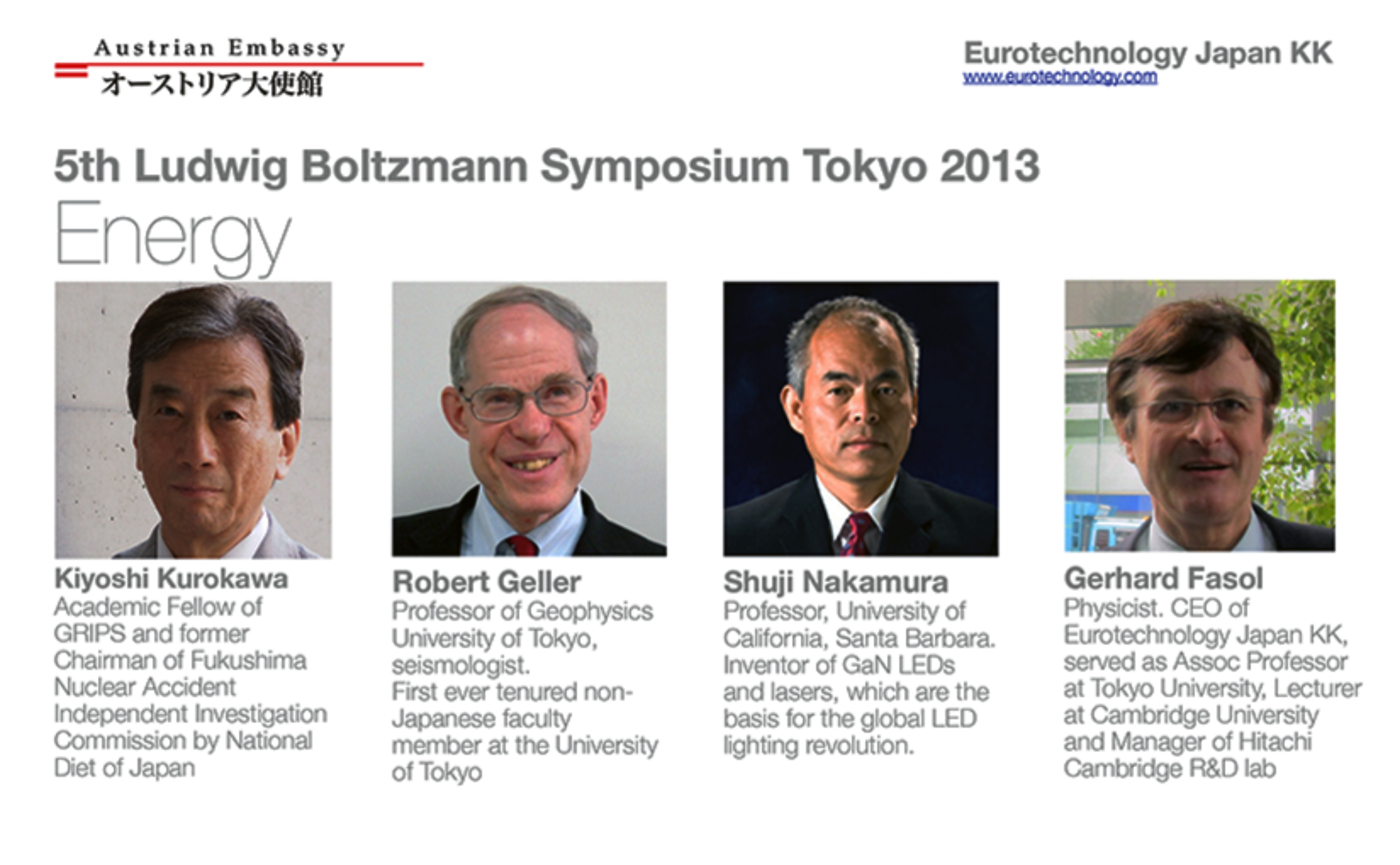Category: Ludwig Boltzmann Symposium
-

Commemorative plate in memory of Ludwig Boltzmann in Duino, Italy
Ceremony on the day of the 170th anniversary of Ludwig Boltzmann’s birthday Commemorating Ludwig Boltzmann’s death on September 5, 1906 On the 170th Anniversary day of Ludwig Boltzmann’s birth, on February 20, 2014, a ceremony was held at the “Ples” Building (Duino no. 76), the building in which Boltzmann passed away on September 5, 1906,…
-

Haruo Kawahara: Speed is like fresh food – Revitalization of Japanese industry
Revitalization of Japanese Industry Haruo Kawahara, Representative Director and Chairman of the Board of JVC KENWOOD Corporation Keynote presented at the 6th Ludwig Boltzmann Symposium on February 20, 2014 at the Embassy of Austria in Tokyo. summary by Gerhard Fasol by Haruo Kawahara, Representative Director and Chairman of the Board of JVC KENWOOD Corporation summary…
-

Kiyoshi Kurokawa: Quo vadis Japan? – uncertain times
Quo vadis Japan? – uncertain times. Groupthink can kill. Kiyoshi Kurokawa Keynote presented at the 6th Ludwig Boltzmann Symposium on February 20, 2014 at the Embassy of Austria in Tokyo. summary by Gerhard Fasol by Kiyoshi Kurokawa, Academic Fellow of GRIPS and former Chairman of Fukushima Nuclear Accident Independent Investigation Commission by National Diet of…
-

Gerhard Fasol: Ludwig Boltzmann – Energy, Entropy Leadership by
Ludwig Boltzmann as leader Gerhard Fasol Keynote presented at the 6th Ludwig Boltzmann Symposium on February 20, 2014 at the Embassy of Austria in Tokyo. (Gerhard Fasol, CEO of Eurotechnology Japan KK. Served as Associate Professor of Tokyo University, Lecturer at Cambridge University, and Manger of Hitachi Cambridge R&D Lab.) Ludwig Boltzmann, the scientist Ludwig…
-

Gerhard Fasol: Boltzmann constant and the new SI system of units by Gerhard Fasol
Boltzmann constant k, “What is temperature?” and the new definition of the SI system of physical units Gerhard Fasol Keynote presented at the 6th Ludwig Boltzmann Symposium on February 20, 2014 at the Embassy of Austria in Tokyo. (by Gerhard Fasol, CEO of Eurotechnology Japan KK. Served as Associate Professor of Tokyo University, Lecturer at…
-

Kenichi Iga: Vertical cavity surface emitting lasers (VCSEL)
VCSEL inventor Kenichi Iga: hv vs kT – Optoelectronics and Energy Kenichi Iga Keynote presented at the 6th Ludwig Boltzmann Symposium on February 20, 2014 at the Embassy of Austria in Tokyo. by: Kenichi Iga, Former President and Emeritus Professor of Tokyo Institute of Technology. Inventor of VCSEL (vertical cavity surface emitting lasers), widely used…
-

5th Ludwig Boltzmann Forum Tokyo 2013
Gerhard Fasol, Chair “ENERGY” Wednesday, 20th February 2013, Embassy of Austria, Tokyo 14:00 Welcome by Dr. Bernhard Zimburg, Ambassador of Austria to Japan 14:10 Gerhard Fasol, “today’s agenda” 14:20 – 14:40 Robert Geller Professor of Geophysics University of Tokyo, seismologist. First ever tenured non-Japanese faculty member at the University of Tokyo “A seismologist looks at…
-

3rd Ludwig Boltzmann Forum Tokyo 2011
Topic “Space and Energy and Ludwig Boltzmann” Gerhard Fasol, Chair Thursday, 17th February 2011 at the Embassy of Austria in Tokyo Program Registration: latest 15 February 2011 Further information: Gerhard Fasol, Georg Poestinger, Counsellor, Austrian Embassy, Tel 03-3451-8281 Summary Gerhard Fasol: “Ludwig Boltzmann: Pioneer of understanding Space and Energy” Gerhard Fasol reviewed Ludwig Boltzmann’s pioneering…